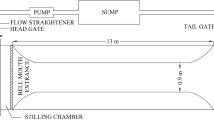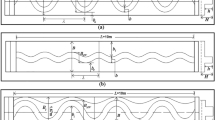Abstract
There are many studies on the hydraulic analysis of steady uniform flows in compound open channels. Based on these studies, various methods have been developed with different assumptions. In general, these methods either have long computations or need numerical solution of differential equations. Furthermore, their accuracy for all compound channels with different geometric and hydraulic conditions may not be guaranteed. In this paper, to overcome theses limitations, two new and efficient algorithms known as linear genetic programming (LGP) and M5 tree decision model have been used. In these algorithms, only three parameters (e.g., depth ratio, coherence, and ratio of computed total flow discharge to bankfull discharge) have been used to simplify its applications by hydraulic engineers. By compiling 394 stage-discharge data from laboratories and fields of 30 compound channels, the derived equations have been applied to estimate the flow conveyance capacity. Comparison of measured and computed flow discharges from LGP and M5 revealed that although both proposed algorithms have considerable accuracy, LGP model with R 2 = 0.98 and RMSE = 0.32 has very good performance.








Similar content being viewed by others
References
Ackers P (1992) Hydraulic design of two-stage channels. J Water Marit Eng 96:247–257
Azamathulla HM, Zahiri A (2012) Flow discharge prediction in compound channels using linear genetic programming. J Hydrol 454–455C:203–207
Bhattacharya B, Solomatine DP (2005) Neural networks and M5 model trees in modeling water level–discharge relationship. NeuroComputing 63:381–396
Bhattacharya B, Price RK, Solomatine DP (2007) Machine learning approach to modeling sediment transport. J Hydraul Eng 133(4):440–450
Blalock ME, Sturm TW (1981) Minimum specific energy in compound channel. J Hydraul Div ASCE 107:699–717
Bousmar D, Wilkin N, Jacquemart H, Zech Y (2004) Overbank flow in symmetrically narrowing floodplains. J Hydraul Eng ASCE 130(4):305–312
Bousmar D, Zech Y (1999) Momentum transfer for practical flow computation in compound channels. J Hydraul Eng ASCE 125(7):696–706
Brameier M (2004) On linear genetic programming. Ph.D. thesis, University of Dortmund
Brameier M, Banzhaf W (2001) A comparison of linear genetic programming and neural networks in medical data mining. IEEE Trans Evol Comput 5:17–26
Chow VT (1959) Open channel hydraulics. McGraw-Hill, London
Etemad Shahidi A, Mahjoobi J (2009) Comparison between M5 model tree and neural networks for prediction of significant wave height in Lake Superior. Ocean Eng 36(15):1175–1181
Guven A (2009) Linear genetic programming for time-series modeling of daily flow rate. Earth Syst Sci 118(2):137
Guven A, Talu NE (2010) Gene-expression programming for estimating suspended sediment in Middle Euphrates Basin, Turkey. Clean: Soil, Air, Water 38(12):1159
Guven A, Gunal M (2008) A genetic programming approach for prediction of local scour downstream hydraulic structures. J Irrig Drain Eng 132(4):241
Guven A, Aytek A (2009) A new approach for stage-discharge relationship: gene-expression programming. J Hydrol Eng 14(8):812–820
Haidera MA, Valentine EM (2002) A practical method for predicting the total discharge in mobile and rigid boundary compound channels. International Conference on Fluvial Hydraulics, Belgium, 153–160
Huthoff F, Roose PC, Augustijn DCM, Hulscher SJMH (2008) Interacting divided channel method for compound channel flow. J Hydraul Eng ASCE 134(8):1158–1165
Haykin S (1999) Neural networks: a comprehensive foundation. Prentice-Hall, Engelwoods Cliffs
Johari A, Habibagahi G, Ghahramani A (2006) Prediction of soil-water characteristic curve using genetic programming. J Geotech Geoenviron Eng 132(5):661–665
Knight DW, Demetriou JD (1983) Flood plain and main channel flow interaction. J Hydraul Div ASCE 109(8):1073–1092
Knight DW, Sellin RHJ (1987) The SERC flood channel facility. J Inst Water Environ Manag 1(2):198–204
Knight DW, Shiono K, Pirt J (1989) Prediction of depth mean velocity and discharge in natural rivers with overbank flow. International Conference on Hydraulics and Environmental Modeling of Coastal, Estuarine and River Waters. England, pp 419–428
Knight DW (1999) Flow mechanisms and sediment transport in compound channels. Int J Sediment Res 14(2):217–236
Lai SH, Bessaih N (2004) Flow in compound channels. 1st International Conference on Managing Rivers in the 21st Century, Malaysia, pp 275–280
Lambert MF, Sellin RHJ (1996) Discharge prediction in straight compound channels using the mixing length concept. J Hydraul Res IAHR 34:381–394
Lambert MF, Myers RC (1998) Estimating the discharge capacity in straight compound channels. Water Marit Energy 130:84–94
Liu W, James CS (2000) Estimating of discharge capacity in meandering compound channels using artificial neural networks. Can J Civil Eng 27(2):297–308
Londhe SN, Dixit PR (2011) Stream flow forecasting using model trees. Int J Earth Sci Eng 4(6):282–285
MacLeod AB (1997) Development of methods to predict the discharge capacity in model and prototype meandering compound channels, PhD Thesis in Civil Engineering, University of Glasgow, p 513
Martin LA, Myers RC (1991) Measurement of overbank flow in a compound river channel. J Inst Water Environ Manag 91(2):645–657
Myers RC, Lyness JF (1997) Discharge ratios in smooth and rough compound channels. J Hydraul Eng ASCE 123(3):182–188
Oltean M, Groşan C (2003) A comparison of several linear genetic programming techniques. Complex Syst 14(1):1–29
Pal M (2006) M5 model tree for land cover classification. Int J Remote Sens 27(4):825–831
Quinlan JR (1992) Learning with continuous classes. In: Proceedings of fifth Australian joint conference on artificial intelligence, Singapore, pp 343–348
Reddy MJ, Ghimire BNS (2009) Use of model tree and gene expression programming to predict the suspended sediment load in rivers. J Intell Syst 18(3):211–227
Sharifi S (2009) Application of evolutionary computation to open channel flow modeling. PhD Thesis in Civil Engineering, University of Birmingham, p 330
Sharifi S, Sterling M, Knight DW (2009) A novel application of a multi-objective evolutionary algorithm in open channel flow modeling. J Hydroinf 11(1):31–50
Shiono K, Knight DW (1991) Turbulent open-channel flows with variable depth across the channel. J Fluid Mech 222:617–646
Shiono K, Knight DW (1988) Two-dimensional analytical solution for a compound channel. 3rd international symposium on refined flow modeling and turbulence measurements, Japan, pp 503–510
Singh KK (2007) M5 model tree for regional mean annual flood estimation. 5th WSEAS international conference on environment, ecosystems and development, Tenerife, Spain, pp 306–309
Solomatine DP, Xue Y (2004) M5 model trees and neural networks: application to flood forecasting in the upper reach of the Huai River in China. J Hydrol Eng 9(6):1–10
Solomatine DP, Dulal K (2003) Model tree as an alternative to neural network in rainfall-runoff modeling. Hydrol Sci J 48(3):399–411
Tarrab L, Weber JF (2004) Predicción del coeficiente de mezcla transversal en cauces aturales. Mecánica Computacional, XXIII, Asociación Argentina de Mecanica Computacional, San Carlos de Bariloche, pp 1343–1355
Tominaga A, Nezu I (1991) Turbulent structure in compound open channel flows. J Hydraul Eng ASCE 117(1):21–41
Unal B, Mamak M, Seckin G, Cobaner M (2010) Comparison of an ANN approach with 1-D and 2-D methods for estimating discharge capacity of straight compound channels. Adv Eng Softw 41:120–129
Witten IH, Frank E (2005) Data mining: practical machine learning tools and techniques with Java implementations. Morgan Kaufmann, San Francisco
Zahiri A, Dehghani AA (2009) Flow discharge determination in straight compound channels using ANN. World Acad Sci Eng Technol 58:1–8
Author information
Authors and Affiliations
Corresponding author
Rights and permissions
About this article
Cite this article
Zahiri, A., Azamathulla, H.M. Comparison between linear genetic programming and M5 tree models to predict flow discharge in compound channels. Neural Comput & Applic 24, 413–420 (2014). https://doi.org/10.1007/s00521-012-1247-0
Received:
Accepted:
Published:
Issue Date:
DOI: https://doi.org/10.1007/s00521-012-1247-0




